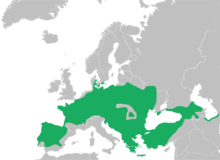Hyla arborea
(Dialihkan dari Katak-pohon Eropa)
| Hyla arborea | |
|---|---|

| |
| Klasifikasi ilmiah | |

| |
| Range as defined by the IUCN in 2009. Some populations (Iberian Peninsula, parts of Eastern Europe, Turkey, and the Black Sea and Caspian Sea regions) are now recognized as separate species | |
| Sinonim[2] | |
|
Hyla arborea adalah katak pohon kecil. Hal ini ditemukan di sebagian besar Eropa, Asia dan Afrika utara.[3][4][5][5][6][7]
Referensi
sunting- ^ IUCN SSC Amphibian Specialist Group (2022). "Hyla arborea". 2022: e.T82496838A82495296. doi:10.2305/IUCN.UK.2022-1.RLTS.T82496838A82495296.en.
- ^ "Hyla arborea (Linnaeus, 1758)". Global Biodiversity Information Facility. Diakses tanggal 31 December 2018.
- ^ Frost, Darrel R. Amphibian Species of the World. Allen Press, Inc., 1985, p. 126.
- ^ Duellman, William E. (2003). Grzimek's Animal Encyclopedia. 2nd Ed., Vol. 2. Gale, p. 235.
- ^ a b Stöck M., Dubey S., Klütsch C., Litvinchuk S.N., Scheidt U., and Perrin N. (2008). Mitochondrial and nuclear phylogeny of circum-Mediterranean tree frogs from the Hyla arborea group. Molecular Phylogenetics and Evolution 49: 1019-1024.
- ^ Stöck M., Dufresnes C., Litvinchuk S.N., Lymberakis P., Biollay S., Berroneau M., Borzée A., Ghali K., Ogielska M., and Perrin N. (2012). Cryptic diversity among Western Palearctic tree frogs: Postglacial range expansion, range limits, and secondary contacts of three European tree frog lineages (Hyla arborea group). Molecular Phylogenetics and Evolution 65: 1-9.
- ^ Haltenorth, T. (1979). British and European Mammals, Amphibians, and Reptiles. Irwin & Co. Ltd., p. 126.
